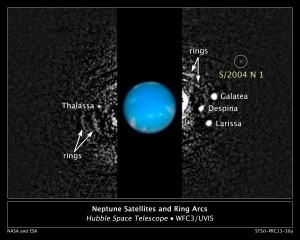THURSDAY, 29 AUGUST 2013
In an age when we are observing new planets around distant stars almost every day, it is stunning to realise there are still things to be discovered in our own celestial back garden. Over the past ten years, in addition to all the deep space probing that made it so famous, the Hubble Space Telescope has collected many images of the planet Neptune. A recent study of these images by Mark Showalter resulted in the identification of a new moon. Showalter has previously identified five other moons and now adds the 14thmoon of Neptune to his list, making a total of 173 moons orbiting planets in our solar system.The eloquently named S/2004 N 1 has remained unidentified for so long, despite a close inspection and a Voyager 2 flyby in 1989, due to its diminutive size. Less than 20km (12 miles) across, it is so small that the city of London could not fit on its surface. The new moon is also 100 million times too faint to be seen from Earth with the naked eye. Many of Neptune’s other moons – including Titan, the largest – were originally passing comets or asteroids captured by the planet’s gravity, however it seems possible that S/2004 N 1 may have formed along with Neptune in the early days of the solar system.
Work is currently underway to clarify the origins and history of S/2004 N 1, as well as to find it a more palatable name. Following the trend of other Neptunian bodies, inspiration is likely to come from the water spirits of ancient Greek or Roman legend.
http://www.nasa.gov/hubble, Release 13-215
Written by Jonathan Lawson.

